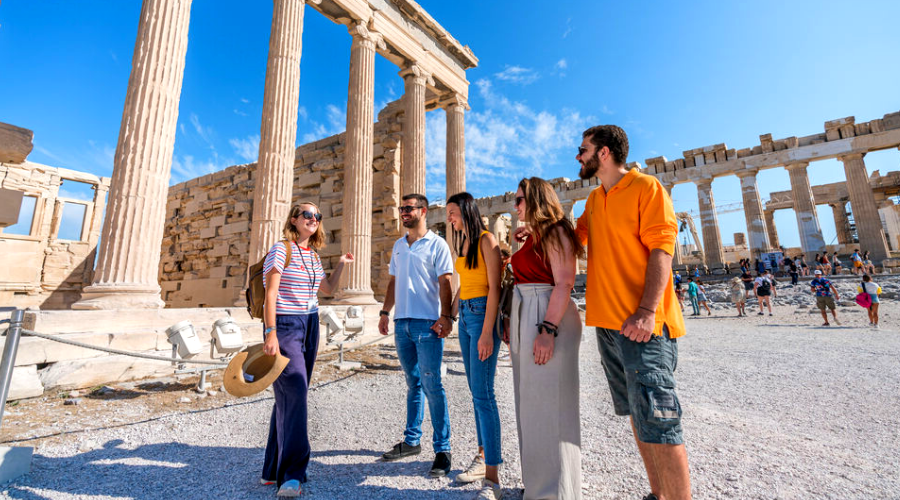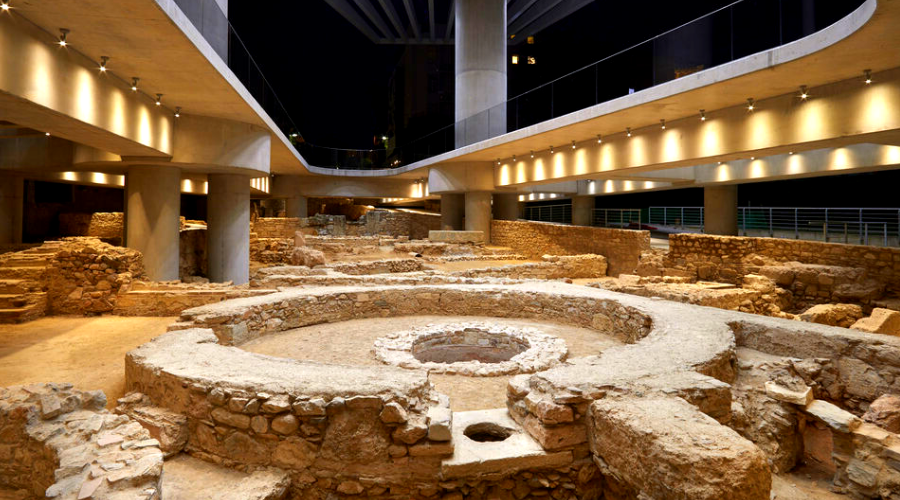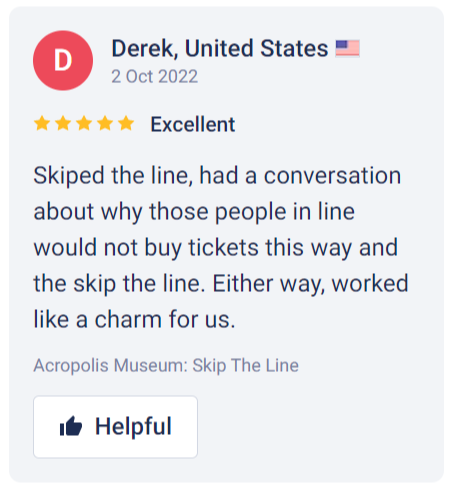Acropolis Museum ticket price for 2024
In this guide, you will learn what the official prices for the
You will also learn:
- How to book
Acropolis Museum tickets in 2024? [Updated Guide]. - Acropolis museum prices.
- Athens
Acropolis Museum opening hours. - Ticket-buying tips.
Where can you Buy a Ticket for the Acropolis Museum Online?
Quick Links to tickets for the Acropolis Museum for the 2024:
► Skip-the-line tickets can be purchased online via:
GetYourGuide.com Click HERE From €12 per person (includes free cancellation)
Tiqets.com Click HERE From €13.00 per person (includes free cancellation)
Viator Click Here From €14.00 per person (includes free cancellation)
Or, read on to learn more about all of your ticket choices as you get ready to visit the
A ticket gets you into the
You can purchase a single-entry ticket for the
Or as a ticket bundle with more Athens archaeological sites.
In addition, there are several guided walking tours and skip-the-line passes.
Below you will find all the information and links.
This article outlines your options, including the numerous ticket kinds offered by legitimate ticket and tour providers as well as the official website of the Greek government.
 Acropolis and 6 Archaeological Sites Combo Ticket
Acropolis and 6 Archaeological Sites Combo Ticket
- Skip-the-line
- Free cancellation.
What are the current admission prices for the Acropolis Museum in 2024?
Acropolis Museum price ticket for WINTER SEASON (1 NOVEMBER – 31 MARCH)
- General admission 5,00€.
- Reduced admission* 3,00 €
(Below in the article there is information about the Reduced admission*)
Acropolis Museum prices tickets for the SUMMER SEASON (1 APRIL – 31 OCTOBER)
- General admission 10,00€.
- Reduced admission* 5,00 €
But buying a ticket involves more than just knowing the cost.
To begin with, some people qualify for discounts. Various ticket kinds, including combination tickets, skip-the-line tickets, and city passes, are also offered.
The optimal choice among these will depend on some variables. Include the attractions you want to see in addition to your budget and time constraints.
Decide on an Experience in the Acropolis Museum
Select from a variety of tickets, tours, and combo packages offered by reputable operators.
The
Advice and Tips for Visiting the Acropolis Museum – Purchase Your Tickets for 2024
I offer my recommendations and buying advice.
Ticket prices for the
Online purchases of skip-the-line tickets are available for the
Includes
- Admission ticket for the
Acropolis Museum - Admission to the underground excavation of an ancient city neighbourhood
- Skip-the-line service
- Wi-Fi
Opening hours New Acropolis Museum 2024
The operating hours of the
November to March
- Monday to Thursday: 09:00 AM–05:00 PM
- Friday: 09:00 AM–10:00 PM
- Saturday and Sunday: 09:00 AM–08:00 PM
April to October
- Monday: 08:00 AM–04:00 PM
- Tuesday to Thursday: 08:00 AM–08:00 PM
- Friday: 08:00 AM–10:00 PM
- Saturday and Sunday: 08:00 AM–08:00 PM
Opening Hours Acropolis Athens 2024
For those planning to visit the
Summer Months (April to October)
- Open daily from 8:00 AM to 8:00 PM.
- The last entry was at 7:30 PM.
Winter Months (November to March)
- Open daily from 8:00 AM to 5:00 PM.
- The last entry was at 4:30 PM.
Acropolis Museum Closure Days
- The
Acropolis is closed on January 1st, March 25th, May 1st, Easter Sunday, December 25th, and 26th. - Additionally, the
Acropolis is closed every Monday between November and March.
Best Time to Visit
- The best time of the day to visit is early in the morning, especially between October and April, to avoid the busy periods and the summer heat.
- On average, a visit to the
Acropolis takes about 1.5 to 2 hours.
Is the Acropolis Open Today?
The
The Athens
- Summer (April to October): 8 AM to 8 PM, with the last entry at 7:30 PM.
- Winter (November to March): 8 AM to 5 PM, with the last entry at 4:30 PM.
The Acropolis is closed on the following dates in 2024:
- January 1
- March 25
- May 1
- Easter Sunday
- December 25 and 26
Additionally, during winter, the
How much do standard admission tickets cost for you to visit the Acropolis Museum in the winter and summer seasons?
The
WINTER SEASON (1 NOVEMBER – 31 MARCH): Acropolis Museum prices tickets
- General admission 5,00€.
- Reduced admission* 3,00 €
Acropolis Museum Athens tickets for SUMMER SEASON (1 APRIL – 31 OCTOBER)
- General admission 10,00€.
- Reduced admission* 5,00 €
What are the admission costs with the Athens City Pass for adults, children, and students, and what is required for age verification?
With the Athens City Pass, admission is free for adults. Children and young people from the EU under the age of 18 as well as students are admitted free. Children and teenagers from non-EU nations over the age of five must pay €3 (from 1 November to 3 March) or €5 to enter (from 1 April to 31 October).
To verify the age, a valid identity card or passport is required.
What can you expect to see and learn about in the Acropolis Museum, including its various galleries and exhibits?
The
The museum has a vast collection of artefacts from the
Several galleries divide the museum, each showcasing different artefacts and exhibits. The museum includes some galleries and exhibits.
The Archaic Gallery displays sculptures and other artefacts from the Archaic period.
It includes the following:
- Korai statues
- Kroisos statue.
The Classical Gallery displays sculptures and other artifacts from the Classical period.
It includes the following:
- Athena Promachos statue
- Parthenon frieze
- Elgin Marbles
In the early 19th century, Lord Elgin removed the “Elgin Marbles” from the Parthenon. The Parthenon Hall features a replica of the Parthenon frieze and these marbles.
This exhibit tells the history of the
The
The museum also has an open-air terrace. It offers a panoramic view of the city and the
What educational programs and activities are available for you?
The museum also offers many educational programs and activities. For example, it has guided tours, lectures, workshops, and interactive exhibits.
Overall, the
Is admission to the Acropolis Museum free?
Entrance to the
You must buy a ticket to access the
Does admission to the Acropolis Museum cost money?
These museums don’t charge much to enter. GetYourGuide and Tiqets both offer discounted tickets for the
The Best Tours of the Acropolis and the Acropolis Museum
You have a choice between hiring a tour guide and visiting the
Tickets for the Acropolis & Acropolis Museum Tour
You must see the things that once adorned the
- The main goal of the
Acropolis Museum trip is to see the things found at theAcropolis . - A great walk given by a qualified archaeologist and expert in the field.
- Before going to the first site, exchange your tickets at the ticket office. It’s 300m south of the
Acropolis . - There is no charge to cancel up to 24 hours before the tour, and you can skip the lines at both sites. The tour lasts four hours.
- Meet your guide at the main door to the
Acropolis Metro stop.
► Skip-the-line tickets can be purchased online via:
GetYourGuide.com Click HERE From €12 per person (includes free cancellation)
Tiqets.com Click HERE From €13.00 per person (includes free cancellation)
Viator Click Here From €14.00 per person (includes free cancellation)
Tickets for the Acropolis Museum are available there.
Purchase general admission tickets at the Museum’s ticket counter or online. Discounted and free tickets are only available at the museum ticket counter with proper identification. Official website Acropolis Museum
Is a trip to the Acropolis Museum worthwhile?
The
What did I see in the Acropolis Museum?
The highlight of the
What may be found in the Acropolis Museum?
The ancient artefacts are located in a sizable trapezoidal hall that is located after the hall. The Erechtheum, the Temple of Athena Nike, and the Propylaea, as well as relics from Roman and early Christian Athens, are located on the same floor as other
Which should you visit first, the Acropolis or the museum?
The Museum can be visited either before or after the
See more here Tickets for the
What makes the Acropolis Museum unique?
It was created by New York architect Bernard Tschumi and local Greek architect Michael Photiadis and serves as the ideal refuge for the historic artefacts discovered near the
Acropolis Museum Tickets
The Acropolis Museum: Why is it So Famous?
One of the top museums in the world is frequently cited as being the
How much time is required to tour the Acropolis Museum?
How long does it take to see the museum at the
Is it okay to snap photos inside the Acropolis Museum?
Amateur filming and photography
All areas of the
What sort of items can you find in the Acropolis Museum?
The Hekatompedon, the oldest structure on the hill, the Propylaia, the Erechtheion, the Sanctuary of Artemis Brauronia, and, of course, the Parthenon are all represented in the museum’s permanent exhibition (the temple of Athena Parthenos).
How many storeys does the museum at the Acropolis have?
The museum’s collections are displayed on three levels, and the offices, café, and museum shop are located on the fourth, centre level.
How many people go to the museum at the Acropolis annually?
More than 1.28 million people enjoyed its displays during the previous year, from June 2019 to June 2020, according to statistics released on Thursday.
Is there a difference between the Acropolis and the museum?
No. The majority of tourists from other countries make this error. The hill on which the Parthenon is located is known as the
Is the Acropolis Museum located there?
No, the Ancient
Does the Acropolis Museum appear on the combination ticket?
Can I get a ticket that includes admission to both the
Where is the Acropolis Museum located?
The
The
Are the exhibits on display at the Acropolis Museum real?
Most
These artefacts are very important. They are from ancient Greek art and culture. We included sculptures, ceramics, inscriptions, and other works. They are from the Archaic, Classical, and Hellenistic eras.
Lord Elgin removed the Parthenon frieze from the Parthenon. He did this in the early 19th century. He kept it in the British Museum. It is a reproduction.
The museum uses original fragments from the site. They use them to recreate features like metopes and pediments. They’re not original, but they show the temple’s look.
The museum’s displays include real artefacts. They reveal the history and culture of ancient Greece.
Acropolis Museum Tickets
Why is the Acropolis Museum in Athens so famous?
There are several reasons why the
The museum is on the south side of the
- Its collection is huge. It has things from the Archaic, Classical, and Hellenistic times. They come from the
Acropolis and old Athens. People think that these artefacts are very important. They are from ancient Greece. They are also thought to have great historical and cultural value. - The Swiss architect Bernard Tschumi created the museum building in modern architecture. It is a gem of modern architecture that combines modern style with old history. People have praised the museum’s style. They say it blends with the natural surroundings and well displays the artefacts.
- Lord Elgin took the “Elgin Marbles” from the Parthenon in the early 1800s. The Parthenon Hall now houses a unique show that includes a copy of the Parthenon wall and these marbles. People can learn about the history and importance of the Parthenon. They can do this while looking at the statues and other artefacts that were once part of the building.
- The museum has many events and programmes for learning. These include guided tours, talks, workshops, and hands-on exhibits. They help people learn about the artefacts and the past of ancient Greece.
The
Tickets to the
What are some good restaurants near the Acropolis Museum in Athens, Greece for a family lunch or dinner with kids?
Athens, Greece, is known for its delicious and diverse cuisine, and many great restaurants near the
- Ta Karamanlidika Tou Fani: This is a traditional Greek taverna that serves homemade Greek dishes, including meat, fish and vegetarian options. The place is known for its friendly atmosphere, great service, and delicious food.
- Avli Tou Thodori: This is a family-friendly restaurant that serves traditional Greek cuisine, including meat and fish dishes, as well as pasta and pizza. The restaurant has a large terrace that is perfect for families.
- To Steki Tou Ilia: This is a cosy taverna that serves traditional Greek food and it’s kid-friendly. The place is known for its friendly service, great food, and reasonable prices.
- The Little Tree: This is a family-friendly, casual place that serves Mediterranean cuisine. The menu includes a variety of options, from sandwiches and salads to pasta and seafood, and it has a kid’s menu.
How can a wheelchair user access the Acropolis Museum and/or Parthenon in Athens, Greece?
The
Here are tips for wheelchair users. They are visiting the
- Ramps and lifts are for wheelchairs. They serve all museum levels.
- Check before your visit to see if the museum has wheelchairs.
- Disabled toilets exist too.
- The museum provides audio tours. The tours are in many languages and for disabled visitors.
- People with trouble walking should visit the museum when it’s less busy. They should avoid peak hours.
The Parthenon sits on the
Always check the website of the Greek Ministry of Culture and Sport. Also, check the Agency of Athens. It is for Development and Destination Management. They have info on access. It covers Covid-19 limits.
Is there an English guide available at The Acropolis Museum in Athens, Greece?
Yes, there is an English guide available at the
The museum also offers audio guides in various languages, including English, which are available for visitors at the museum’s ticket office. These audio guides provide detailed information about the artefacts and exhibits on display, and they are a great way to explore the museum at your own pace.
It’s always recommended to check the official website of the
What are the advantages of the Acropolis Museum in Athens, Greece over other museums of ancient Greek artifacts like Delphi or Olympia?
People think the
- Acropolis Museum is on the south side of the
Acropolis hill, close to the ancient site. This makes it a great spot to learn about theAcropolis and old Athens’ history and culture. The museum is unique. It puts artefacts in the setting of the old city. This helps you understand what theAcropolis Hill means. - The Museum of
Acropolis has collected many things from the Archaic, Classical, and Hellenistic times. It found them on theAcropolis and in old Athens. People think that these artefacts are very important. They are some of the best examples of Greek art and culture. They are from ancient Greece. They are also thought to have great historical and cultural value. The museum has a huge collection of sculptures. It also has building parts from the Parthenon temple. You can’t find them in any other museum. - The Swiss architect Bernard Tschumi created the museum building. It is a modern architectural masterpiece that combines modern style with ancient history. People have complimented the museum’s style. It fits in with the natural surroundings and shows off the artefacts well.
- Parthenon Hall hosts a unique show. It features a replica of the Parthenon Wall and the “Elgin Marbles.” Lord Elgin took them from the Parthenon in the early 1800s. Visitors can learn about the Parthenon’s history and importance. They can see the statues and artefacts that were part of the building.
- The museum has many events and programs for learning. These include guided walks, talks, workshops, and hands-on exhibits. They help people understand the artefacts and the history of ancient Greece.
Because of this, the
Were the statues and structures in classical Greece always white?
Ancient Greek sculptures and architecture weren’t usually white. Artists in ancient Greece painted statues and structures. They used vivid colors of many hues and tints.
Ancient Greeks painted their sculptures in bright colours. These colours included red, blue, yellow, and green. They used them to convey passion, movement, and lifelikeness. Artists painted patterns, motifs, and details on the statues.
Architects painted ancient Greek buildings brilliant colours, with distinct tints for architectural components. The Parthenon frieze depicts a religious procession. Painters would use red, blue, and gold to highlight and add depth to the intricacies. Architects would have used different colours for columns and other architectural components.
However, weathering, pollution, and other causes have worn away the paint on them. Most ancient Greek statues and structures are white or light. This is because the paint has worn off and exposed the marble.
Modern Greek sculptures and architecture are different from those of ancient times. Weather, humans, nature, and restoration and conservation have impacted them.
Google arts and culture Acropolis Museum
The
You can:
- Zoom in and out on artefacts. You can also
- See 360-degree views of displays. You can see
- Info about their history.
All this is now available on Google Arts & Culture. It also offers a virtual tour of the Parthenon Hall. Visitors can see the frieze restoration. They can also learn about the temple’s history.
The portal also has high-res artefact photos. It has essays and videos about the
You can’t visit the
What is there at the Acropolis Museum?
The
The museum has many rooms, one of which is the Archaic Gallery. This room has sculptures from the Archaic period. It has the statue of the “Korai” and the “Karyatids” sculptures. In the Classical Gallery, you can see works from the Classical period. They include “Athena Promachos.” They also include the Parthenon frieze. Lord Elgin took the “Elgin Marbles” from the Parthenon in the early 1800s. He put them in the Parthenon Hall, which has a copy of the Parthenon wall.
The museum has an exhibit about the history of the
The
Is the Acropolis and Acropolis Museum the same?
The
The
- The Parthenon
- Erechtheion
- Propylaea
World Heritage Site by UNESCO. It is one of the most famous places in the world. It is also historically important.
The
Briefly, the
Which is better the Acropolis Museum or the National Archaeological Museum?
Acropolis Museum and National Archaeological Museum are in Athens, Greece. They provide separate and unique experiences.
The
The museum is one of Greece’s and the world’s most important archaeological museums. The museum has ancient Greek sculptures, pottery, jewellery, and inscriptions. They reveal ancient Greece’s history and culture.
You must see the
Why can’t you take photos?
The
- Museum galleries prohibit flash and tripods. This prevents flash damage and maintains safe lighting conditions. The light may also reflect on delicate artefacts. They are irreplaceable and behind glass, which obscures the view.
- Professional photography and filmmaking need museum management authorization and may cost more. Always check the
Acropolis Museum’s website. Also, check the Greek Ministry of Culture and Sport’s website. They have updates on the photo policy. Also, check for Covid-19 changes.
It’s also crucial to respect the artefacts. Don’t take photos or recordings. These might upset visitors or harm the displays.
PLAN YOUR VISIT
The
The Athens
- Purchase tickets in advance: Use the museum’s ticket office or buy online. A combined ticket to the
Acropolis Museum and site is another option. - Plan your visit: The museum has several galleries with diverse artefacts and displays. Plan your route and galleries.
- Dress modestly: Visitors must always wear shirts and shoes. Prohibiting tank tops, shorts, and miniskirts.
- Respectful behaviour is key. The museum is a cultural institution. Thus, visitors should respect the artefacts.
- In museum galleries, you can take personal photos. But, we prohibit the use of flash and tripods.
- Food and drinks: The museum prohibits eating and drinking.
- Guided tours: Guided tours may explain the artefacts’ history and value.
- Accessibility: The museum offers ramps and lifts for disabled users.
Follow these recommendations to maximise your
Acropolis Museum Artifacts
- The
Acropolis Museum has Archaic, Classical, and Hellenistic sculptures. It also has ceramics, inscriptions, and other artefacts. They are from theAcropolis and ancient Athens. Artefacts of note in the museum include: - Parthenon frieze: The museum features a copy of the
Acropolis temple’s Parthenon frieze. On the frieze, people see a religious procession honouring Athena. - The museum’s Archaic Gallery has many “Korai” sculptures. They are female figures used as
Acropolis architectural features. They are among Greece’s finest Archaic sculptures. - Six female sculptures held up the porch. They were at the Erechtheion, an ancient
Acropolis temple. “Karyatids” is their name.” The museum displays five of these sculptures. - The “Athena Promachos” statue is in the museum’s Classical Gallery. It displays one of Athena’s most famous sculptures. Produced about 460 BC, this Classical sculpture is one of Greece’s most prominent.
Acropolis Museum Exhibits
- The
Acropolis Museum displaysAcropolis and ancient Athens artefacts in numerous exhibitions. Notable displays include: - The Archaic Gallery has the “Korai” and “Kroisos” statues. It also has other Archaic artefacts on exhibit.
- The Classical Gallery has Classical sculptures and artefacts. It includes the “Athena Promachos” statue, the Parthenon frieze, and “Elgin Marbles”.
- Parthenon Hall is a unique display. It includes a reproduction of the Parthenon frieze and the “Elgin Marbles”. Lord Elgin removed them in the early 19th century.
- The museum has an exhibit on the
Acropolis Hill and its monuments. It also has a section on ancient Athenians’ daily lives. This section includes pottery, jewellery, and other artefacts. - The
Acropolis Restoration Service lets visitors watch. They can see the restoration of theAcropolis sculptures and monuments. They can also learn about protecting historic heritage. - The terrace: The museum features an outdoor terrace with a view of the city and the
Acropolis .
Each exhibit shows ancient Athens’ history and culture. To learn about the artefacts and their origins, visit them.
Acropolis Museum Wikipedia
The
The museum has a huge collection of things from the
There is also a deck outside the museum with a great view of the city and the
People think the
The Parthenon Gallery
The Parthenon Gallery is also known as the Parthenon Hall. It is at the
The exhibit has a replica of the Parthenon frieze. The frieze depicted an Athena-honoring procession. The gallery displays the “Elgin Marbles.” They are marble statues that Lord Elgin saved from the Parthenon in the early 19th century. Elgin Marbles are among the finest ancient Greek sculptures in the world.
The Parthenon Gallery also showcases metopes, pediments, and architectural features from the temple. The exhibit also discusses the Parthenon, its sculptures, and their surroundings.
Visit the Parthenon Gallery to learn about ancient Athens and the Parthenon temple. You should see it if you’re visiting the
Top 5 Reasons to Visit
Athens is synonymous with the
This museum has risen to the top of my list of favourite places. It shocked me with how much I enjoyed it. The structure is a work of art. Its traditional surrounds created it to echo and honour. The museum aligns the lower levels with the ruins below. It angles the top level to replicate the Parthenon above.
1. The Slopes Gallery
The clear floor of the
2. The Ancient Gallery
This spacious, lit gallery has columns. It houses sculptures from around 700 BC to 480 BC. After the Dark Ages, the Archaic Period saw the rise of the city-state. It also saw big progress in literature, art, and democracy. The kouros and kore statues are male and female. They are flawlessly symmetrical. But, they are inflexible. They also lack the Greek sculptures’ individualism. These are the features. They are most often linked to Greece. They caught my attention in particular.
3. The Caryatid Women
Lord Elgin removed the sixth column in 1801. These 5 of the original 6 columns now form one of the museum’s most striking displays. They support the south porch roof of the Erechtheion. Noble women serve as models for the sculptures. They complete the temple’s Ionic architecture and are exquisite in form and performance. This is especially useful. You can’t get as near to the real Erechtehion porch at the
4. Procession to the Parthenon
The literal cherry on top is the third floor of the museum. It focuses on the most famous building on
The Parthenon has east and west pediments. Each shows the birth of Athena and her conflict with Poseidon over Attica. They are also replicas at either end of the gallery. Few details are available. You can use surrounding models to fill in the blanks. You can still see the Parthenon’s 92 original metopes. They are marble panels. They showed scenes from legendary conflicts, along with their remaining fragments.
5. A View-Oriented Restaurant
A quick dinner or beverage at the museum’s restaurant on the second level would be a good way to round off your tour. In the warmer months, you can see the nearby Parthenon and the city skyline. The vast outdoor terrace is very relaxing at sunset. Additionally, the restaurant is open late on Fridays.
 Before you buy tickets, read the guide for 2024. Click Here
Before you buy tickets, read the guide for 2024. Click Here




